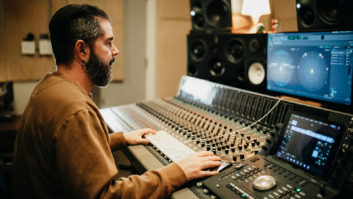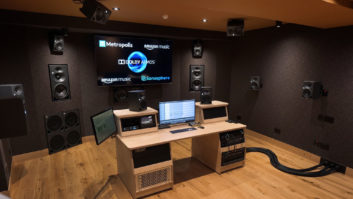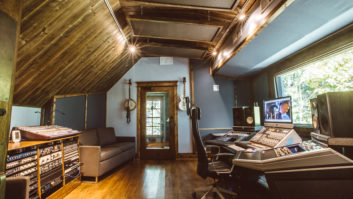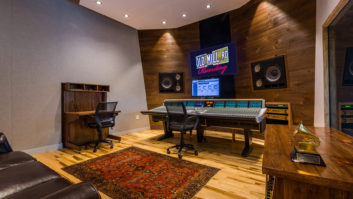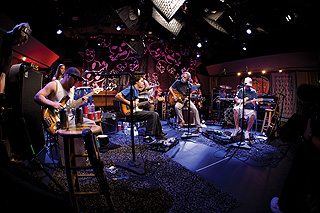
Overview of Slightly Stoopid Webcast
Photos: ©2011 Anne Cutler
During their 30 years together, the Grateful Dead established themselves as audio innovators of the highest order (no pun intended). They were the first group to use top-shelf hi-fi components as part of their SR setup, and among the first to regularly employ monitor wedges. They hot-rodded everything from guitars to amplifiers to loudspeakers in search of cleaner and more powerful sound, and their justifiably legendary Wall of Sound system in the early ’70s remains a model (albeit a financially impractical one) of how to deliver pristine audio to large numbers of people. The Dead also always supported up-and-coming instrument and gear artisan, from Alembic and Doug Irwin on the guitar/bass front, to Meyer Sound loudspeakers and Gamble front-of-house and monitor boards. Guitarist Bob Weir and drummer Mickey Hart were both home studio pioneers.
Sixteen years down the line from Grateful Dead guitarist Jerry Garcia’s death, both Weir and Hart continue to push the sonic envelope onstage and in their studios, always looking for that next cool audio thing—often putting their own money toward redefining the “state of the art.” In Weir’s case, that has led to a fascinating new venture known as TRI Studios in San Rafael, Calif. TRI—an acronym for Tamalpais Research Institute (Mt. Tamalpais being the most prominent topographical feature in the region)—is an 11,500-square-foot warehouse studio complex that includes two large rehearsal/recording/performance spaces, two audio control rooms, a video-editing room, five iso rooms, machine rooms and a handful of offices. Initially designed to be, in Weir’s words, “the ultimate playpen for musicians,” it is fast-evolving into something much bigger. The past few months have seen several hi-def Webcasts featuring Furthur (Weir’s jam band with Grateful Dead bassist Phil Lesh and others), stoner reggae/rock/hip-hop groovers Slightly Stoopid and the supergroup Chickenfoot.
Weir did have another rehearsal space in San Rafael he hoped to turn into a proper studio, when the building that now houses TRI—the former home of Bay Area Sound Studios rehearsal studios—became available. “I’d just come off the [2009] Dead tour and had some nickels in my jeans and it came on the market,” Weir says. “The deal is it had close to $1 million of acoustical treatment put into it [by BASS], so for almost anyone who would buy a building like that, all that would have to come out and it would be really expensive. The asking price was real cheap on that account so I waited and bought it. What really caused all this to happen was at the end of the fall of 2009, the good folks at API were doing a little show at AES in New York and they invited me to come back and play their little hoe-down. In return they offered me a real swell deal on their top-of-the line, all-the-bells-and-whistles 5.1, 48-in board. So I jumped at that.”
With that choice API Vision board as the anchor, Weir next enlisted a pair of old friends to help him turn the new building into a world-class facility. Studio COO John Cutler had been in the Grateful Dead orbit since the early ’70s, as an equipment designer, mixer for numerous live broadcasts, co-producer and engineer on their two ’80s albums (In the Dark and Built to Last), FOH engineer for the Jerry Garcia Band for many years and, ultimately, for the Grateful Dead from the spring of ’94 until Garcia’s passing in the summer of ’95. Another tech expert, Dennis “Wiz” Leonard, also came onto the Dead scene in the early ’70s and has worked on and off with them ever since while establishing himself as an in-demand film sound supervisor and mixer.
Wiz comments, “John [Cutler] and I and a guy named Matt Lavine from a company called Bug ID [pronounced “bug-eyed”; a Bay Area A/V system design and integration firm] designed the wiring infrastructure, and the three of us chose the gear. I did all the renovation drawings for the control room and did all the acoustics and the performance room.”
In addition to the API console, the main control room contains Meyer Sound Acheron mains and HD-1s for near-fields, X-800 subs, six UPJ-1p surrounds in the soffit, three large video screens under the mains, Pro Tools|HD DAWs, a pair of Studer 824 multitracks, and plenty of high-end analog and digital processing gear. The “B” control room is centered around the Sony MXP-3000 console that was part of Weir’s home studio. All of the performance, control and iso rooms can be tied together.

The main control room
HEAVENLY CONSTELLATION
The 2,000-square-foot Studio One, down a long hallway from the main control room but tied in by video feed, features the facility’s Meyer Constellation system: an acoustic modeling system that uses evenly spaced, small custom microphones hanging from the ceiling throughout the room and inside the soffits, along with scads of hidden low-voltage Meyer UP4XPs, UP Juniors and double-12-inch subs. Says Wiz, “What they do is virtually upholster the room with speakers and microphones, and what you end up with modeling any acoustic environment. There are more than 20 mics, and there is no area that is hot and also none that is devoid of pickup from the mics. It’s a system that’s really part of the room.” Wiz says that presets already exist for Carnegie Hall, Amsterdam’s Concertgebouw and even one for Grace Cathedral in San Francisco, but there are seemingly limitless variations. Meyer Sound originally designed the flexible system to be used primarily in orchestral applications, but Weir was interested in adapting it to amplified music.

The main studio, empty, with Constellation system mics and speakers visible
The system’s first “test-drive” came in the summer of 2009, when John Meyer invited Weir to bring his band RatDog into Meyer Sound’s Pearson Theatre to try out the system. “Bob was pushing it to the limit in terms of what we designed it to do,” comments Meyer’s Michael Maxon, who was also on hand for the Stoopid Webcast. “Originally, the intent was to just re-create a few different presets [of acoustic spaces], but Bob was looking at it as being part of the band—like an extension of the band. He was also looking at it as a way to rehearse and prep for a tour. You could change the space and make it sound like an arena or a theater with horrible slap-back.”
SUBTLE STOOPID
When I arrive at TRI a couple of hours before the Webcast, the whole facility is buzzing with activity. In the main control room, Wiz is sitting at the API with Slightly Stoopid’s regular FOH mixer, James Wisner who relays how he sets up the group’s usual Avid VENUE D-Show FOH board and discusses specific processing they might want to employ. The sound coming through the HD-1s is incredibly clean and clear, and when they A/B certain inputs on the Acheron mains, the crystalline signal fairly explodes in the room with a pleasing visceral punch.
On the large screens in front of the console, Wiz can follow the action in the performance studio as it’s directed by veteran filmmaker/videographer Justin Kreutzmann, who is calling the shots from the video suite down the hall. The active shot appears in glorious HD on the center screen, while smaller versions of the other camera views (there are five) take up another screen.
Over in the main performance space, Slightly Stoopid is bopping through an extensive rehearsal/soundcheck with guest singer Don Carlos, a Jamaican dancehall great formerly in the groundbreaking band Black Uhuru. As I walk into the room, I’m struck by the incredible clarity of the sound. There’s a lot going on musically—the expanded band includes the core septet of leaders Miles Doughty and Kyle McDonald switching off on guitars and bass, drummer Ryan “Rymo” Moran, keyboardist Paul Wolstencroft, percussionist Oguer Ocon, trumpeter C-Money and saxophonist Dela, augmented by Dumstaphunk members Ian and Ivan Neville on guitar and organ, respectively, and jam-band saxophonist Karl Denson. Still, every subtle nuance can be distinctly heard in the room through the two Meyer UPQs that hang above each side of the performance area, aided by a pair of M3D subs. At the suggestion of James Wisner, the band is set up differently than usual, with the drums on the right side (instead of dead center), keyboards center rear.
The Constellation system’s many mics hang discreetly from the black ceiling, but the system’s many smaller loudspeakers are all but invisible. For this show, a pair of widely spaced AKG 414s about two-thirds of the way back from the band are picking up the sound of the room (and feeding into the Constellation system’s software that is “reading” the space). This time out, there is a single Constellation setting being employed for the performance—“to give a little life to the room,” comments Slightly Stoopid monitor mixer and production manager Josh Driscoll, who is manning one of the studio’s Gamble EX-56 boards in the back of the room, directly facing the band as if it were the FOH position. The four wedges for the show were Meyer UM and UM100s.
SHOW TIME
Once the show begins—following an introduction by stoner hero Tommy Chong—Doughty and McDonald lead the big group through its paces, trading off on lead vocals all night, hitting many different nuggets from the group’s deep catalog and traversing multiple styles, often within the same song. There’s an overall mellowness to the sound, yet the interlocking parts fall together with a remarkable intensity. Weir comes out for a couple of songs and Don Carlos brings his authentic reggae spirit (and gravitas) to the proceedings for several numbers. While there are reportedly some glitches in the Internet transmission of the show (on the server end), inside TRI, the hi-fi audio and hi-def video operations are as smooth as Slightly Stoopid’s bright and infectious music.
